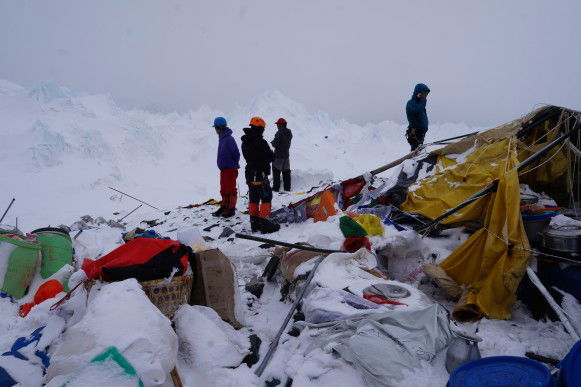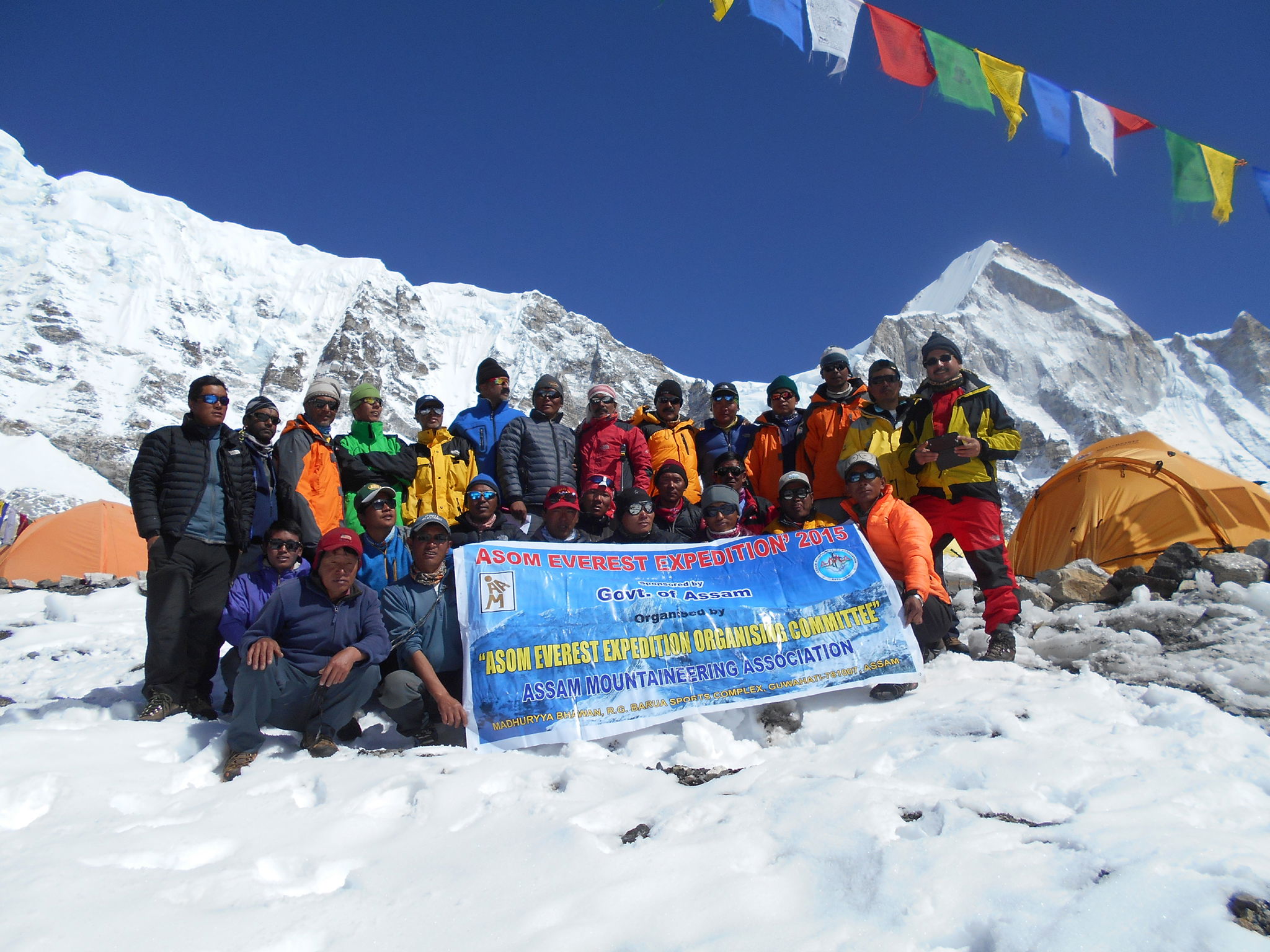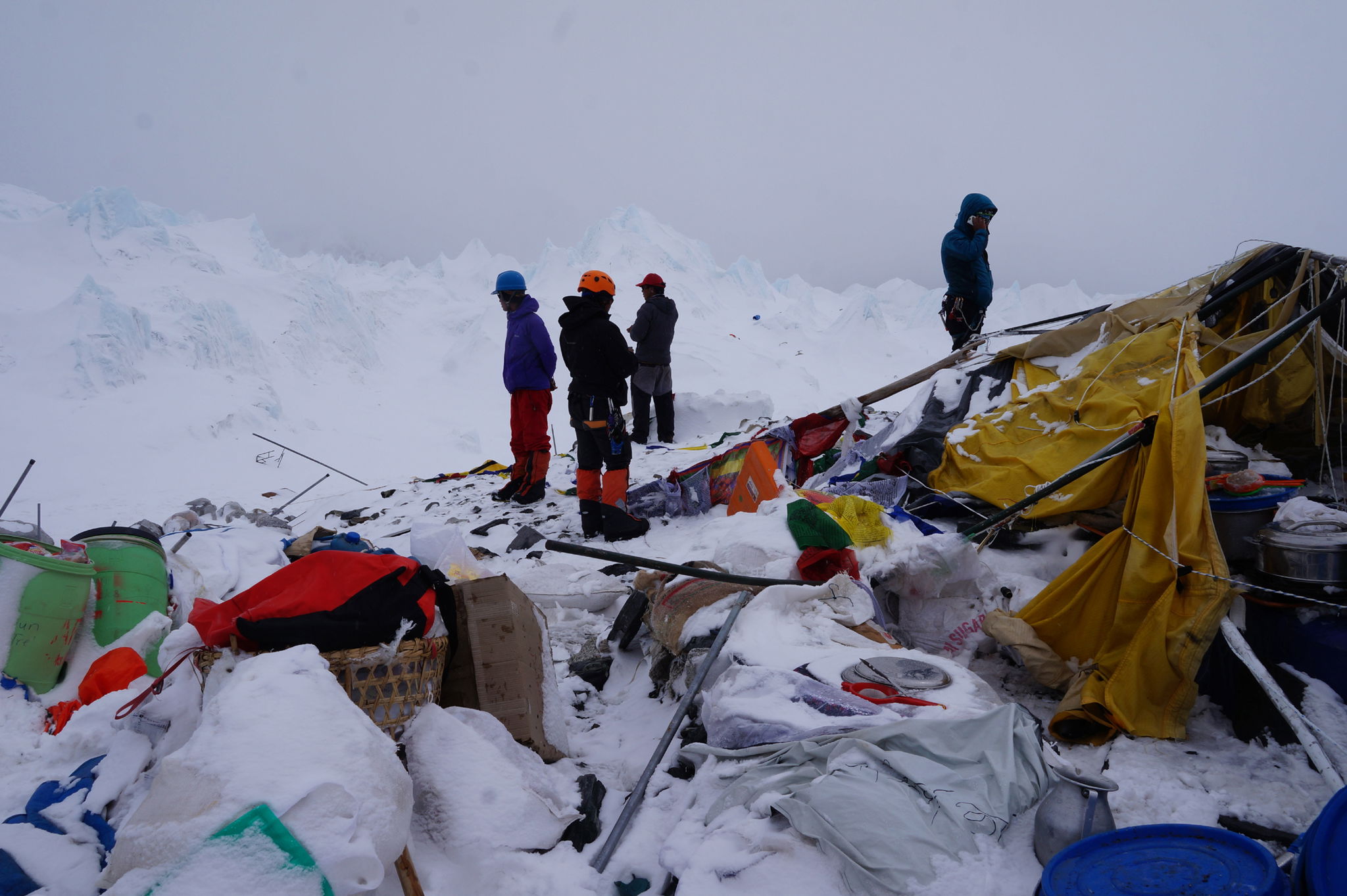Articles features
Everest Base Camp survivor: A month after quake, horror is still alive

Everest Base Camp survivor: A month after quake, horror is still alive
By Pranay Bordoloi Guwahati, May 24 It had been snowing heavily from the wee hours. It seemed like it would never end. The whole Everest Base Camp was clad in white. The mercury plummeted below zero degree Celsius.
It was tough to leave the warmth of the sleeping bag. Coming out of the tent, we freshened up and had our breakfast. As planned, we got ready to undergo icecraft training. While tackling the dangerous Khumbu icefall on our way from the Base Camp to Camp 1, crevasses had developed and we had to cross these with the help of aluminium ladders.
We had fixed April 25 as the day for practising zumaring -- using a small mechanical device to ascend on a rope -- on the icewall. Despite heavy snowfall, we decided to go ahead with our plans. Around 9 a.m., we went out for training at a glacier, at the lower reaches of the Khumbu icefall. Because of the heavy snowfall, most of the Everest expedition teams had stayed put inside their tents at the Base Camp.
Our sherpa sardar, Lakpa Randruk Sherpa, had led Everest expedition teams at least 10 times. He had also successfully led teams to the world's second highest peak, K2, and the third highest, Kanchenjunga, among other Himalayan peaks. Out of the eight sherpas in our team, seven had climbed Mount Everest more than once.
That was perhaps the reason why we did not oppose Lakpa's move to continue icecraft training in heavy snowfall. The training spot was around 300 metres away and 200 feet above the Base Camp, located at an altitude of 17,500 feet.
By 11.45, most of our training was over. Our team doctor, Jagadish Basumatary, was practising zumaring while another member, Parag, was rappelling down. We were busy talking with Lakpa standing on an ice platform. We were about to wrap up our training for the day and return to the Base Camp.
All of a sudden, we felt the platform shaking. Soon, the entire area was trembling. We feared that the platform would cave in. When we realised that it was an earthquake, all the team members and the sherpas got together. Just at that time we heard a deafening sound from the top of the mountain and looked up. We saw an avalanche rushing down from the Nuptse peak behind us. Not only Nuptse, avalanches were rushing down from other peaks like Ama Dablam and Lola because of the temblor. The scene was breathtaking as well as frightening.
There was another deafening sound. We saw a huge avalanche rushing down from the Pumori peak in front of us. Nepali people regard the Pumori peak as the daughter of Mt. Everest. Disaster struck in the blink of a moment. The avalanche from the Pumori peak hit the Base Camp. All the equipment in our camp was swept away.
We were mute witnesses to the gigantic fury of nature and stood totally helpless. Everything was beyond our control. The merchant of death did not stop there. After completely destroying the Base Camp, the avalanche moved towards us.
Before we realised, we were faced with being buried in snow. Lakpa shouted at everyone in our group to take the 'avalanche position' -- to hold each other's hands and squat on the snow. Once the snow buried us, it was total darkness around us. Breathing with much difficulty, I tried to stand up by removing the snow from my head.
After the avalanche had crossed, it lost momentum and came to a stop. We heaved a sigh of relief to see all members of our team were safe. We realised that we had managed to escape death by the skin of our teeth.
Looking at the Base Camp, we saw that there was no sign of tents -- in fact, no sign of life.
In my earlier Everest expedition in 2012, I had seen avalanches but nothing of such devastating proportions. The avalanche from the Pumori peak took just eight to nine seconds to reach us. One can just imagine the speed of the moving mass of snow.
We felt like we had got a new lease of life. We collected all the equipment with us and hurried towards the Base Camp area. The scene in front of us was that of total destruction. Of the 25 tents that we had put up, 22 were either totally buried in snow or swept away. My own tent was buried in snow around 150 feet below.
There was a hue and cry at the Base camp. We came to know that a number of sherpas and mountaineers had lost their lives and many others were injured. Two doctors were thrown off and killed. The body of one of them, a Chinese citizen, was found near our tent. He was in his inner wear, inside a sleeping bag. The other doctor was an American.
Those who survived made temporary stretchers with ropes and sleeping bags and carried bodies and grievously injured mountaineers down. We came to know later that, in all, 19 mountaineers, including seven foreigners, were killed while more than 50 others were injured. Most of them were inside their tents when the avalanche struck.
None from our team of eleven was injured. Two of our Base Camp managers, Sailen and Amar, had a miraculous escape. When we went out for icecraft training in the morning, they had not joined us.
Just before noon, Amar was bringing tea for us. Sailen did not want to accompany him because of the snowfall but Amar pulled him out. The moment they reached us at our training site, the avalanche struck. Had Sailen stayed back in the tent, one can well imagine what would have happened to him.
Prior to our expedition, we had visited some temples and offered our prayers. Maybe God heard us and hence our miraculous escape.
Almost all camps on the three-kilometre-long Base Camp were destroyed.
Our team doctor started tending to others who were injured. One sherpa died in his arms.
Suddenly we saw another youth from Assam, Naba Phukan, running towards us. He was with another expedition called Seven Summit Treks. The avalanche did not cause much damage to the tents in their area. I hugged him and he helped me recover some of my equipment.
That day the special dish planned for lunch at our camp was sour fish curry, a traditional Assamese delicacy. I had not had fish after leaving Assam on April 3. Realising this, Amar had specially ordered fish via helicopter from Kathmandu. We had hoped to relish the food at the end of the day's training. But that was not to be.
Not just our lunch, the devastating avalanche swept away everything in its wake. With no tent to take shelter at night and with no food, our team was compelled to come down. Exhausted and tired, we checked into the last tourist lodge on the way to the Base Camp. It was evening, but the snow continued to fall.
Our sherpas had gone ahead of us and had set up a few camps for us on the sprawling snow-covered valley below a place called Gorakshep. However, seeing our exhausted condition, our team leader, Manash Barooah, ordered the sherpas to look for rooms in tourist lodges.
It was only after we entered our rooms that we felt some relief. With breakfast having been our last meal of the day, we were mentally and physically tired.
Our year-long preparations for the Everest expedition was thrown into total disarray by nature's fury.
We know that we cannot continue our Everest expedition this year. Will our Everest expedition remain a dream forever?
(Pranay Bordoloi is a senior journalist and a veteran mountaineer. He was a part of Asom Everest Expedition 2015 and this was his second attempt at the world's highest mountain.
Guwahati, May 24 It had been snowing heavily from the wee hours. It seemed like it would never end. The whole Everest Base Camp was clad in white. The mercury plummeted below zero degree Celsius.
It was tough to leave the warmth of the sleeping bag. Coming out of the tent, we freshened up and had our breakfast. As planned, we got ready to undergo icecraft training. While tackling the dangerous Khumbu icefall on our way from the Base Camp to Camp 1, crevasses had developed and we had to cross these with the help of aluminium ladders.
We had fixed April 25 as the day for practising zumaring -- using a small mechanical device to ascend on a rope -- on the icewall. Despite heavy snowfall, we decided to go ahead with our plans. Around 9 a.m., we went out for training at a glacier, at the lower reaches of the Khumbu icefall. Because of the heavy snowfall, most of the Everest expedition teams had stayed put inside their tents at the Base Camp.
Our sherpa sardar, Lakpa Randruk Sherpa, had led Everest expedition teams at least 10 times. He had also successfully led teams to the world's second highest peak, K2, and the third highest, Kanchenjunga, among other Himalayan peaks. Out of the eight sherpas in our team, seven had climbed Mount Everest more than once.
That was perhaps the reason why we did not oppose Lakpa's move to continue icecraft training in heavy snowfall. The training spot was around 300 metres away and 200 feet above the Base Camp, located at an altitude of 17,500 feet.
By 11.45, most of our training was over. Our team doctor, Jagadish Basumatary, was practising zumaring while another member, Parag, was rappelling down. We were busy talking with Lakpa standing on an ice platform. We were about to wrap up our training for the day and return to the Base Camp.
All of a sudden, we felt the platform shaking. Soon, the entire area was trembling. We feared that the platform would cave in. When we realised that it was an earthquake, all the team members and the sherpas got together. Just at that time we heard a deafening sound from the top of the mountain and looked up. We saw an avalanche rushing down from the Nuptse peak behind us. Not only Nuptse, avalanches were rushing down from other peaks like Ama Dablam and Lola because of the temblor. The scene was breathtaking as well as frightening.
There was another deafening sound. We saw a huge avalanche rushing down from the Pumori peak in front of us. Nepali people regard the Pumori peak as the daughter of Mt. Everest. Disaster struck in the blink of a moment. The avalanche from the Pumori peak hit the Base Camp. All the equipment in our camp was swept away.
We were mute witnesses to the gigantic fury of nature and stood totally helpless. Everything was beyond our control. The merchant of death did not stop there. After completely destroying the Base Camp, the avalanche moved towards us.
Before we realised, we were faced with being buried in snow. Lakpa shouted at everyone in our group to take the 'avalanche position' -- to hold each other's hands and squat on the snow. Once the snow buried us, it was total darkness around us. Breathing with much difficulty, I tried to stand up by removing the snow from my head.
After the avalanche had crossed, it lost momentum and came to a stop. We heaved a sigh of relief to see all members of our team were safe. We realised that we had managed to escape death by the skin of our teeth.
Looking at the Base Camp, we saw that there was no sign of tents -- in fact, no sign of life.
In my earlier Everest expedition in 2012, I had seen avalanches but nothing of such devastating proportions. The avalanche from the Pumori peak took just eight to nine seconds to reach us. One can just imagine the speed of the moving mass of snow.
We felt like we had got a new lease of life. We collected all the equipment with us and hurried towards the Base Camp area. The scene in front of us was that of total destruction. Of the 25 tents that we had put up, 22 were either totally buried in snow or swept away. My own tent was buried in snow around 150 feet below.
There was a hue and cry at the Base camp. We came to know that a number of sherpas and mountaineers had lost their lives and many others were injured. Two doctors were thrown off and killed. The body of one of them, a Chinese citizen, was found near our tent. He was in his inner wear, inside a sleeping bag. The other doctor was an American.
Those who survived made temporary stretchers with ropes and sleeping bags and carried bodies and grievously injured mountaineers down. We came to know later that, in all, 19 mountaineers, including seven foreigners, were killed while more than 50 others were injured. Most of them were inside their tents when the avalanche struck.
None from our team of eleven was injured. Two of our Base Camp managers, Sailen and Amar, had a miraculous escape. When we went out for icecraft training in the morning, they had not joined us.
Just before noon, Amar was bringing tea for us. Sailen did not want to accompany him because of the snowfall but Amar pulled him out. The moment they reached us at our training site, the avalanche struck. Had Sailen stayed back in the tent, one can well imagine what would have happened to him.
Prior to our expedition, we had visited some temples and offered our prayers. Maybe God heard us and hence our miraculous escape.
Almost all camps on the three-kilometre-long Base Camp were destroyed.
Our team doctor started tending to others who were injured. One sherpa died in his arms.
Suddenly we saw another youth from Assam, Naba Phukan, running towards us. He was with another expedition called Seven Summit Treks. The avalanche did not cause much damage to the tents in their area. I hugged him and he helped me recover some of my equipment.
That day the special dish planned for lunch at our camp was sour fish curry, a traditional Assamese delicacy. I had not had fish after leaving Assam on April 3. Realising this, Amar had specially ordered fish via helicopter from Kathmandu. We had hoped to relish the food at the end of the day's training. But that was not to be.
Not just our lunch, the devastating avalanche swept away everything in its wake. With no tent to take shelter at night and with no food, our team was compelled to come down. Exhausted and tired, we checked into the last tourist lodge on the way to the Base Camp. It was evening, but the snow continued to fall.
Our sherpas had gone ahead of us and had set up a few camps for us on the sprawling snow-covered valley below a place called Gorakshep. However, seeing our exhausted condition, our team leader, Manash Barooah, ordered the sherpas to look for rooms in tourist lodges.
It was only after we entered our rooms that we felt some relief. With breakfast having been our last meal of the day, we were mentally and physically tired.
Our year-long preparations for the Everest expedition was thrown into total disarray by nature's fury.
We know that we cannot continue our Everest expedition this year. Will our Everest expedition remain a dream forever?
(Pranay Bordoloi is a senior journalist and a veteran mountaineer. He was a part of Asom Everest Expedition 2015 and this was his second attempt at the world's highest mountain.









































